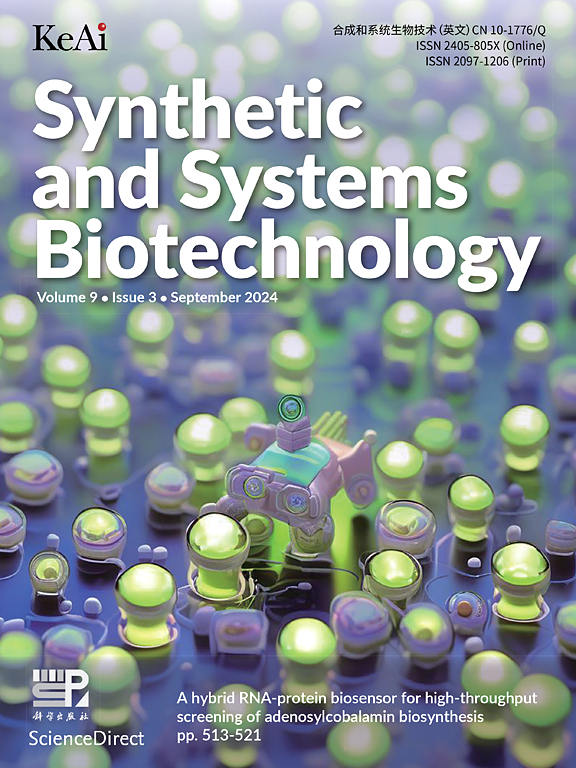Development of precise genome editing and multi-copy integration tools in Hansenula polymorpha DL-1
IF 4.4
2区 生物学
Q1 BIOTECHNOLOGY & APPLIED MICROBIOLOGY
引用次数: 0
Abstract
Hansenula polymorpha DL-1 is a thermotolerant yeast capable of utilizing multiple renewable carbon sources, making it a promising microbial cell factory for sustainable manufacturing. However, advanced metabolic engineering efforts have been constrained by its strong non-homologous end joining (NHEJ) mechanism and limited choice of suitable genetic tools. This study presents an optimized synthetic biology toolkit to address these limitations. A high-efficiency CRISPR-Cas9-based genome editing system was established, achieving an editing efficiency of 97.2 %. To further enhance homologous recombination (HR), the NHEJ pathway was partially suppressed by knocking out KU80 and overexpressing HR-related genes from Saccharomyces cerevisiae. This increased HR rates to 88.9 %. In addition, 36 neutral sites were identified for stable single-copy gene integration without disrupting native gene expression cassettes. Finally, multi-copy integration tools were developed by targeting rDNA and Ty elements, leading to a ∼60-fold increase in β-carotene production compared with single-copy integrants. Furthermore, squalene titers were increased from 0.1 mg/L in the wild-type strain to 187.2 mg/L through iterative multi-copy integration. These advances significantly expand the genetic tractability of H. polymorpha DL-1, underscoring its potential as a versatile platform for efficient and sustainable production of value-added compounds.
多态羊草DL-1精确基因组编辑和多拷贝整合工具的开发
多态Hansenula polymorpha DL-1是一种耐热酵母,能够利用多种可再生碳源,使其成为一种有前途的可持续生产微生物细胞工厂。然而,由于其强大的非同源末端连接(NHEJ)机制和合适的遗传工具选择有限,高级代谢工程的努力受到限制。本研究提出了一个优化的合成生物学工具包来解决这些限制。建立了基于crispr - cas9的高效基因组编辑系统,编辑效率达97.2%。为了进一步增强同源重组(homologous recombination, HR),通过敲除酿酒酵母(Saccharomyces cerevisiae)的KU80和过表达HR相关基因,部分抑制了NHEJ通路。这将人力资源率提高到88.9%。此外,在不破坏原生基因表达磁带的情况下,还鉴定了36个稳定的单拷贝基因整合中性位点。最后,通过rDNA和Ty元件开发了多拷贝整合工具,与单拷贝整合物相比,β-胡萝卜素产量增加了约60倍。此外,通过迭代多拷贝整合,角鲨烯滴度从野生型菌株的0.1 mg/L提高到187.2 mg/L。这些进展显著扩大了H. polymorpha DL-1的遗传可追溯性,强调了其作为高效和可持续生产增值化合物的多功能平台的潜力。
本文章由计算机程序翻译,如有差异,请以英文原文为准。
求助全文
约1分钟内获得全文
求助全文
来源期刊

Synthetic and Systems Biotechnology
BIOTECHNOLOGY & APPLIED MICROBIOLOGY-
CiteScore
6.90
自引率
12.50%
发文量
90
审稿时长
67 days
期刊介绍:
Synthetic and Systems Biotechnology aims to promote the communication of original research in synthetic and systems biology, with strong emphasis on applications towards biotechnology. This journal is a quarterly peer-reviewed journal led by Editor-in-Chief Lixin Zhang. The journal publishes high-quality research; focusing on integrative approaches to enable the understanding and design of biological systems, and research to develop the application of systems and synthetic biology to natural systems. This journal will publish Articles, Short notes, Methods, Mini Reviews, Commentary and Conference reviews.
 求助内容:
求助内容: 应助结果提醒方式:
应助结果提醒方式:


